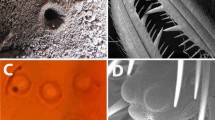Summary
-
1.
When the flagellum of the second antenna of a blinded crayfish is lightly touched with a fine brush, the animal withdraws its antenna and attacks the point of stimulation. We studied the dynamics of this attack and describe experiments designed to identify the sensory information used by the animals to guide their actions.
-
2.
For a successful attack crayfish simultaneously turn and move towards the ‘target position’, while making grasping movements with their chelae (Figs. 2, 3). The time course of all three components of this preprogrammed action pattern depends on the angular position of the antennae and on the distance between the point of stimulation along the flagellum and the animal's body (Fig. 6).
-
3.
During an attack the animals have no sensory feedback about their position relative to the ‘target position’. Since they simultaneously rotate and translate towards the ‘target position’ the direction they have to take depends on how much they translate while rotating. It can be shown that the animals correct the angular position errors introduced by their own translation (Fig. 9).
-
4.
The angular position of the flagellum is monitored by chordotonal organs in the basal joints of the antenna. Splinting the basal joints, however, has no detectable effect on the accuracy of attacks (Fig. 7). This means that the angular position must be monitored by non-adapting tonic position sensitive receptors in the chordotonal organ.
-
5.
To test whether crayfish gain positional information from their flagella, these were bent and splinted. The direction of the attacks before and after this operation were recorded. When flagella are bent laterally the animals correct the direction of the attack accordingly. With medially bent flagella the direction of attack is not modified (Fig. 8).
Similar content being viewed by others
References
Bender M, Gnatzy W, Tautz J (1984) The antennal feathered hairs in the crayfish: a non-innervated stimulus transmitting system. J Comp Physiol A 154:45–47
Collett TS, Harkness LK (1982) Depth vision in animals. In: Ingle DJ, Goodale MA, Mansfield RJW (eds) Analysis of visual behaviour. MIT Press, Cambridge London
Sandeman DC (1985) Crayfish antennae as tactile organs: their mobility and the responses of their proprioceptors to displacement. J Comp Physiol A 157:363–373
Sandeman DC, Sandeman RE (1984) Crayfish antennae: a sophisticated tactile sensory system. Proc Aust Physiol Pharmacol Soc 15:194P
Taylor RC (1975) Physical and physiological properties of the crayfish antennal flagellum. J Neurobiol 6:501–519
Tautz J, Masters WM, Aicher B, Markl H (1981) A new type of water vibration receptor on the crayfish antenna. I. Sensory physiology. J Comp Physiol 144:533–541
Zeil J, Sandeman R, Sandeman D (1985) Tactile localisation: the function of active antennal movements in the crayfishCherax destructor. J Comp Physiol A 157:607–617
Author information
Authors and Affiliations
Rights and permissions
About this article
Cite this article
Sandeman, D.C., Varju, D. A behavioural study of tactile localization in the crayfishCherax destructor . J. Comp. Physiol. 163, 525–536 (1988). https://doi.org/10.1007/BF00604906
Accepted:
Issue Date:
DOI: https://doi.org/10.1007/BF00604906




